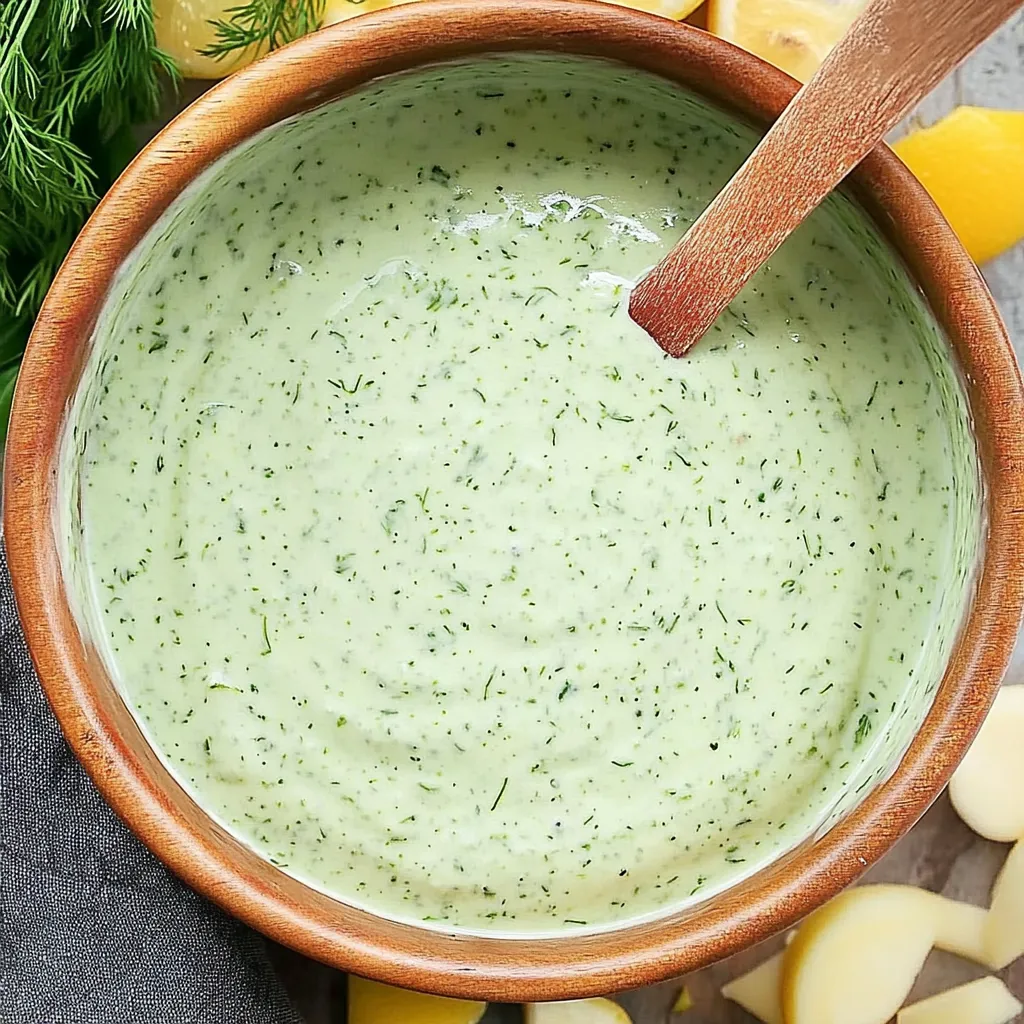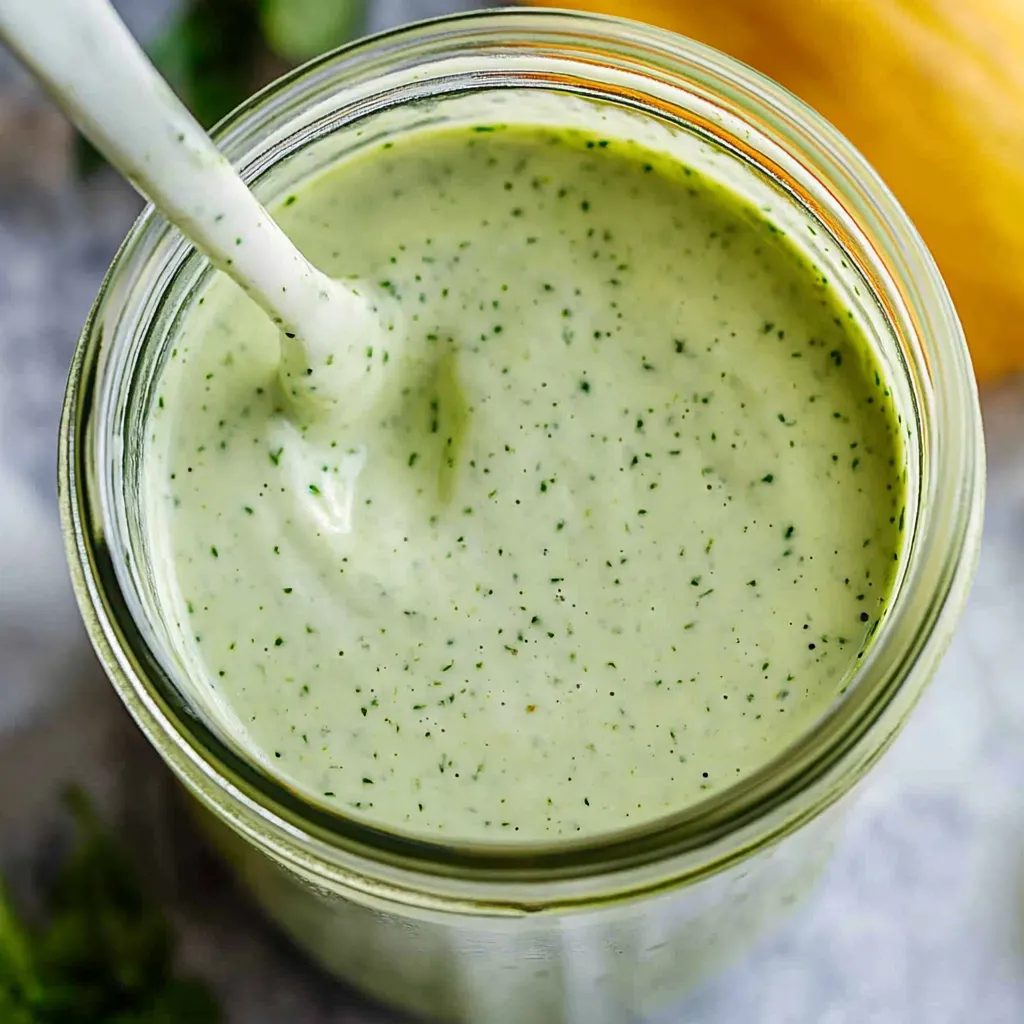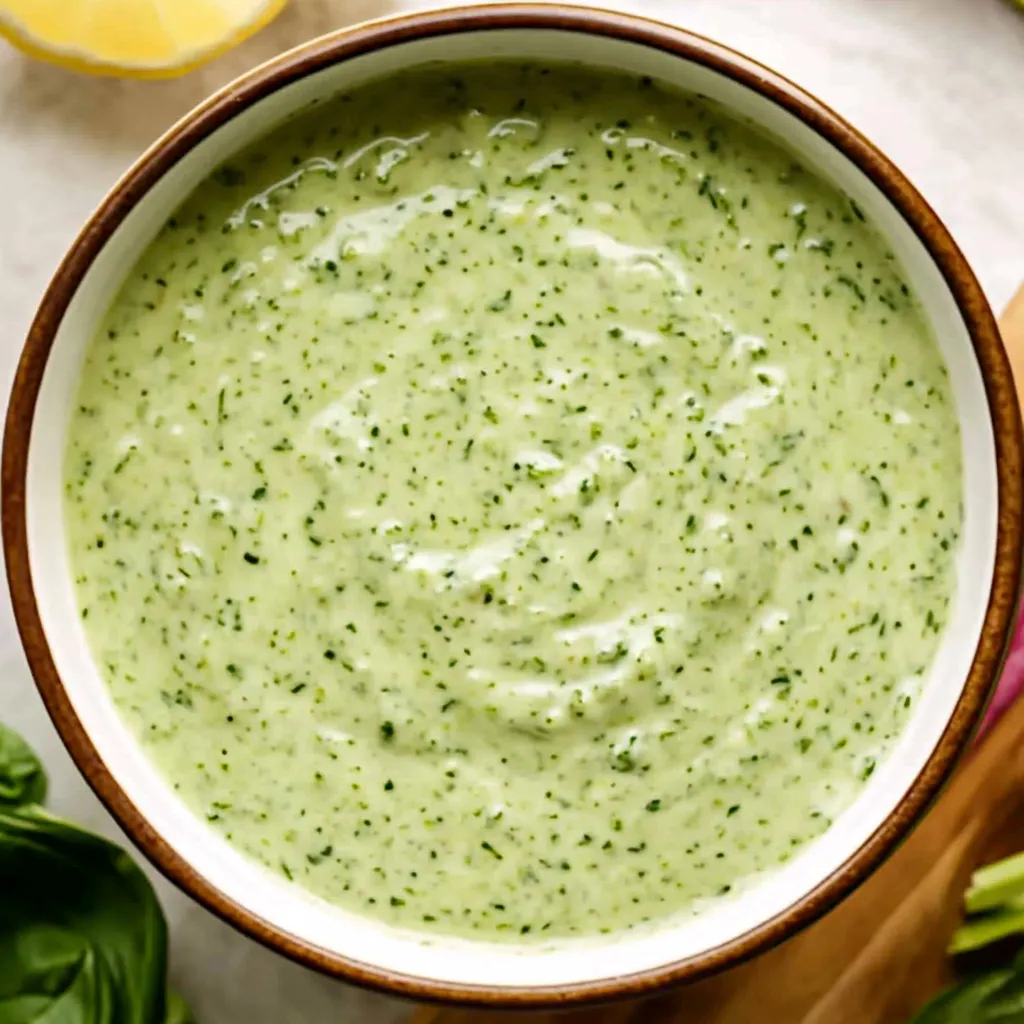 Pin it
Pin it
This green goddess dressing transformed the way my family eats salads, turning what used to be a boring side dish into something everyone actually gets excited about. The vibrant green color catches your eye immediately, but it's the fresh, herby flavor with that perfect creamy tang that keeps you coming back for more. I started making this about three years ago when I was trying to get my kids to eat more vegetables, and now they request it so often that I keep a jar in the fridge at all times.
My daughter initially refused to try anything green, but one day she accidentally dipped a carrot stick in this instead of ranch dressing and her eyes got huge. Now she fights with her brother over who gets to pour it on their salad, and I consider that a major parenting win.
Ingredients You'll Need
- Mayonnaise: (about half a cup) - Forms the rich, creamy base that makes this dressing luxurious and helps it cling to salad greens instead of sliding off; use your favorite brand, whether that's regular or a lighter version
- Plain Greek yogurt: (about half a cup) - Adds tanginess and body while making the dressing a bit healthier with extra protein; full-fat gives the best texture, but low-fat works fine too, and you can substitute sour cream if that's what you have
- Fresh basil leaves: (a generous handful) - Brings that sweet, slightly peppery herb flavor that's essential to the dressing's character; use leaves only, not stems, and make sure they're dry or your dressing will be watery
- Fresh dill: (another generous handful) - Adds that distinctive bright, slightly tangy herb flavor that makes this taste fresh and garden-like; the feathery fronds are what you want, not the tough stems
- Fresh lemon juice: (from about one lemon) - Provides acidity that cuts through the richness of the mayo and yogurt, brightening all the flavors and preventing the dressing from tasting heavy; always use fresh squeezed, not bottled
- Dijon mustard: (a tablespoon or so) - Delivers savory depth and a subtle sharpness that balances all the herbs beautifully; the original recipe used anchovies, but Dijon gives similar umami without needing another ingredient
- Fresh garlic: (one or two cloves) - Adds a punchy bite that makes the dressing more complex and interesting; use fresh cloves that you peel and roughly chop, not jarred minced garlic
- Salt and black pepper: (to taste) - Enhances all the other flavors and prevents the dressing from tasting flat; start with less than you think and adjust after blending
Step-by-Step Instructions
- Add all ingredients to your blender in the right order:
- Start by adding your mayonnaise and Greek yogurt to the bottom of your blender jar, which creates a base that helps pull the other ingredients down toward the blades for smoother blending. Tear or roughly chop your fresh basil and dill, then pile them on top of the creamy mixture along with the peeled garlic cloves that you've given a quick rough chop to help them blend easier. Squeeze your fresh lemon juice directly into the blender, being careful to catch any seeds in your hand before they fall in, then add your Dijon mustard along with a good pinch of salt and several grinds of black pepper. The order matters less in a high-powered blender, but putting liquids and soft ingredients at the bottom helps everything blend more smoothly without leaving chunks of herbs stuck to the sides.
- Blend until completely smooth and vibrantly green:
- Secure the lid tightly on your blender and start on low speed for just a few seconds to get everything moving and combining, then gradually increase to high speed and blend for about thirty seconds total. You'll see the herbs break down and the mixture transform from streaky white with green flecks into a gorgeous, uniform bright green color that looks almost too pretty to eat. Stop the blender and use a spatula to scrape down the sides if you see any large pieces of herbs stuck there, then blend for another few seconds until everything is silky smooth with no visible herb pieces remaining. The texture should be thick and creamy, coating the back of a spoon without being so thick that it won't pour, and that vibrant green color tells you all those fresh herbs have been perfectly incorporated.
- Taste and adjust the seasoning to your preference:
- Carefully dip a clean spoon into the dressing and taste it, really paying attention to the balance of flavors and thinking about whether it needs anything. If it tastes too rich or heavy, add another squeeze of lemon juice to brighten it up and make it more refreshing. If the flavors seem muted or flat, it probably needs more salt, so add a pinch at a time and taste again until everything pops. Some people like more garlic punch, in which case you can add another small clove and blend again, while others prefer more herb flavor and might toss in a few extra leaves of basil or dill before blending one more time.
- Serve immediately or refrigerate to thicken:
- You can use this dressing right away if you're serving it immediately, pouring it into a small bowl as a dip or drizzling it over your prepared salad. However, I usually prefer to transfer it to a glass jar or airtight container and refrigerate it for at least thirty minutes before serving, which allows it to thicken up to an even better consistency that clings to vegetables and greens more effectively. The cold temperature also helps the flavors meld together and develop, making the second-day dressing even more delicious than when you first made it.
 Pin it
Pin it
I've experimented with different herb combinations over the years, and while basil and dill are my favorite everyday version, using tarragon and parsley makes it taste more sophisticated for dinner parties. My husband loves the version with cilantro and mint, which I make specifically for fish tacos, and it's become his favorite way to eat grilled salmon.
Choosing and Preparing Your Fresh Herbs
The quality and freshness of your herbs make an enormous difference in how this dressing turns out, so it's worth being picky at the store or farmers market. Look for herbs that are bright green with no yellowing or brown spots, and stems that are crisp rather than slimy or wilted. When you get them home, wash them gently in cool water and dry them thoroughly using a salad spinner or by patting them with paper towels, because excess water dilutes the dressing and makes it watery. Strip the leaves from the stems since the stems can be tough and bitter, though tender dill fronds are fine to use with their delicate stems attached. Store any leftover herbs wrapped in a barely damp paper towel inside a plastic bag in the crisper drawer, which keeps them fresh for several extra days.
Understanding the Creamy Base
The combination of mayonnaise and Greek yogurt creates a base that's richer than yogurt alone but lighter and tangier than pure mayo, giving you the best of both worlds. Mayo contributes that silky, emulsified texture that makes dressings cling to salad greens beautifully, while Greek yogurt adds protein and a pleasant tang that prevents everything from feeling too heavy. The yogurt also thins the dressing slightly compared to all mayo, making it easier to drizzle and toss with salads. If you're avoiding dairy, coconut yogurt or cashew yogurt work as substitutes, though they'll give slightly different flavors. Sour cream can replace the Greek yogurt in a pinch and actually makes the dressing even tangier, which some people really love.
Blender versus Food Processor Results
I've made this dressing both ways many times, and while both are delicious, the differences are noticeable enough to mention. A high-powered blender creates the silkiest, most uniform texture because the blades spin so fast and the narrow jar forces everything through the blades multiple times. The color comes out incredibly vibrant and saturated because the herbs get broken down so finely. A food processor works but requires longer processing time, usually a minute or two of pulsing and scraping down the sides, and you'll end up with a slightly chunkier texture with visible flecks of herbs. The color also tends to be lighter and less vibrant because the wider bowl doesn't force ingredients through the blade as efficiently. Both versions taste great, so use whatever equipment you have available.
Creative Ways to Use This Beyond Salads
Once you have a jar of this in your fridge, you'll find yourself reaching for it constantly because it improves so many different dishes. I love using it as a marinade for chicken breasts that I'm grilling, letting them sit in the dressing for a few hours before cooking, which keeps them incredibly moist and adds flavor throughout. It makes an excellent sandwich spread that's way more interesting than plain mayo, especially on turkey or chicken sandwiches loaded with vegetables. Stirring a few spoonfuls into pasta salad instead of regular dressing transforms it into something special, and drizzling it over roasted vegetables like cauliflower or Brussels sprouts makes even veggie-haters ask for seconds. My kids dip everything from chicken nuggets to sweet potato fries into it, treating it like an upgraded ranch dressing.
Adjusting Consistency for Different Uses
The thickness of your dressing affects how well it works for different purposes, and you can easily adjust it by adding small amounts of water or extra lemon juice. For salad dressing, you want it thin enough to toss easily with greens but thick enough to cling to the leaves, which is what you get straight from the blender. As a dip for vegetables or chips, you want it thicker and creamier, so refrigerating it for an hour or longer gives you that perfect scoopable consistency. For drizzling over proteins or using as a sauce, thin it slightly with a tablespoon or two of water so it flows smoothly without being gloppy. As a marinade, the original consistency works perfectly, coating meat evenly without sliding off.
Storing and Keeping It Fresh
Glass jars work wonderfully for storing this dressing because they don't absorb odors or stains, and you can see exactly what you have left without opening the container. Mason jars are my favorite because they're the right size and have tight-sealing lids that prevent leaks. Always store it in the refrigerator since the fresh herbs and dairy ingredients can spoil at room temperature, and give it a good shake before each use because the ingredients may separate slightly as it sits. The dressing stays freshest for about five to seven days, depending on how fresh your herbs were when you made it, though the color may fade from that vibrant green to a more muted olive as it ages. Don't worry if you see the color change; it still tastes just as good even when it's not quite as bright.
 Pin it
Pin it
This green goddess dressing has become one of those recipes I make so automatically that I don't even need to measure anymore, and having it in the fridge means I'm always ready to throw together a quick, healthy meal that actually tastes exciting. The fact that something this delicious and versatile takes less than five minutes to make feels almost too good to be true, but here we are, and I'm never going back to boring bottled dressings again.
Frequently Asked Questions
- → Can I make this dressing without a blender?
- Yes, you can use a food processor instead. It will take about 3 to 5 minutes to get smooth, and the color might be a bit less vibrant, but it will still taste great.
- → How long does green goddess dressing last in the fridge?
- It keeps well for up to one week when stored in an airtight container in the refrigerator. Just give it a stir if it separates.
- → Can I use different herbs in this recipe?
- Absolutely! You can swap basil and dill for cilantro, parsley, mint, tarragon, or chives. Use whatever fresh herbs you have on hand.
- → Is this dressing good for anything besides salads?
- Yes! It works as a dip for veggies, fries, and chicken tenders, or you can use it as a marinade for chicken, fish, or other proteins.
- → Can I use sour cream instead of Greek yogurt?
- Yes, sour cream works perfectly as a substitute for Greek yogurt. The texture and flavor will be very similar.
- → Why does my dressing look less green than expected?
- If you used a food processor, the herbs don't break down as finely as they do in a blender, so the color won't be as bright. It will still taste delicious though.
- → Can I make this dressing dairy-free?
- You can try using dairy-free yogurt and vegan mayo, though the taste and texture might be slightly different from the original version.
